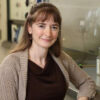
Pompano, Rebecca
Primary Appointment
Associate Professor, Chemistry
Education
- BS, , University of Richmond
- PhD, , University of Chicago
- Postdoc, , University of Chicago
Contact Information
Telephone: 434-982-1825
Email: rrp2z@virginia.edu
Website: http://www.pompanolab.com
Research Disciplines
Biophysics, Biotechnology, Cancer Biology, Experimental Pathology, Immunology, Metabolism, Microbiology, Molecular Pharmacology, Neuroimmunology, Translational Science
Research Interests
Bioanalytical tools for inflammatory disease
Research Description
Our lab develops methods based on microfluidic culture systems, bioanalytical techniques, and spatially resolved simulations to quantify the spatiotemporal dynamics of the inflammatory cascade and develop targeted therapies. This work is part of a broad interest in the dynamics of complex biological systems. Specifically, we study the kinetics of immunity and inflammation, and we develop chemically targeted methods to control these processes in the context of vaccination, autoimmunity, and chronic inflammatory disease.
The immune system is a fascinating topic for physical scientists to study, and one where novel analytical tools can make a significant impact. The system consists of a highly structured network whose components include a set of specialized cell types and secreted signals, which organize themselves into dynamic spatial arrangements. These components interact with all of the characteristics of mathematical complexity, including nonlinearity, thresholds for activation, and multiple length scales, and they exhibit emergent behaviors that are difficult to predict from knowledge of the individual components. As a result of this complexity, protective immune responses against invading pathogens and injected vaccines are only a small perturbation away from the non-productive inflammation that characterizes autoimmunity, heart disease, Alzheimer’s disease, and solid tumors. Despite a wealth of information about individual proteins and cells in the immune system, it is challenging to predict the effects of a given stimulation of the immune system. One reason is that chemical stimulation of individual clusters of cells is still difficult to achieve in vitro or in vivo. Spatially resolved readout of secreted molecules is also difficult, unless the molecules can be fluorescently labeled. Without such tools, it remains unclear how to stop an autoimmune disease without suppressing the entire immune system, or how to design potent vaccines that work for any disease target without unwanted inflammatory side effects.
We are developing new methods to study the kinetics and the spatial behavior of cells and secreted signals during immune responses. For example, we are designing microfluidic devices to test the effects of spatial distribution and local delivery of signals. We also are developing new ways to measure the secretions of cells in living tissues with high spatial and temporal resolution. To do so, we combine activities from a variety of disciplines, including microfabrication and device design; quantitative analysis of chemical and biochemical signals using immunoassays, HPLC, mass spectrometry, and fluorescence microscopy (widefield and confocal); live cell and tissue imaging using samples from mouse models of health and disease; and, finally, spatially-resolved time-dependent numerical simulations. Eventually, we will use the information from these experiments to design spatially targeted nanoparticles that abrogate inflammation. Our goal is that the methods we develop will enable experiments that contribute to the fundamental understanding of both immunity and complex chemical kinetics, and that they will help guide the design of highly targeted vaccines and immunotherapies.
